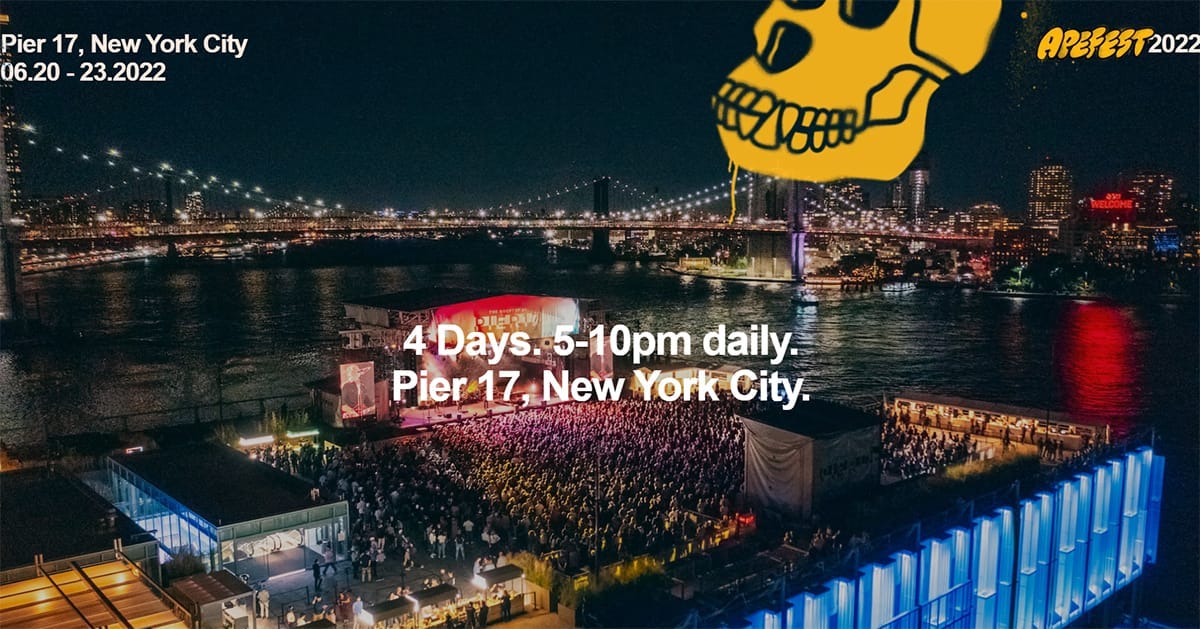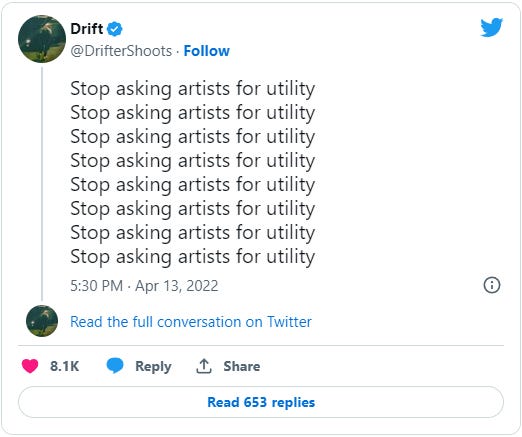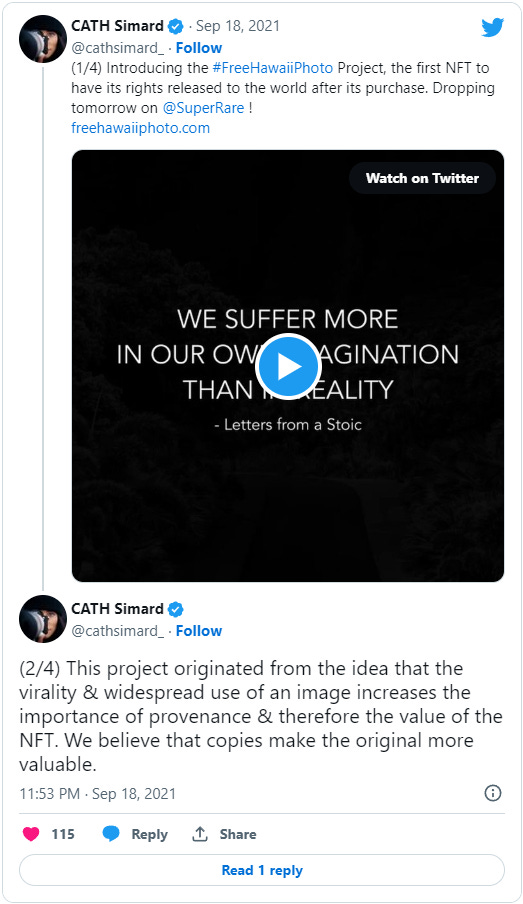How to Monetise Intellectual Property in the Digital Age of Web3
Lessons from the Music Industry for a Web3 Future
Who Is This Episode For & Read Time
The entire episode, approx. 12 minutes - for Brands, Content Creators, and Artists interested in Web3; and
The 1st part of this episode, approx. 5 minutes - for existing Web3 Community Members wanting to better understand how IP monetisation works.
Disclaimer
Please remember that this content is for informational purposes only, and that (as the name of this newsletter suggests) should not be taken as legal advice. If you have legal questions, you should reach out to a qualified lawyer.
The Story
As summer drew to a close, Brianna lay on the floor, listening to music and eagerly awaiting the start of the school year. She was excited to reunite with her school friends, many of whom had gone on holiday abroad.
A knock on the door interrupted her daydreams.
"Just a moment!" she called out, turning down the volume of her favourite song as she headed to the door. She opened it, revealing a man wearing a pizza delivery uniform with a pizza box in his hands. With an air of surprise, he asked: "Hi, are your parents at home?" Brianna replied: "No, but you have the wrong address. I didn't order a pizza." The man looked at a small piece of paper in his hand and said: "Well, the address is correct, so this must be the right place...", and then proceeded to open the pizza box revealing its content (a folder?!) and exclaimed: "Ma'am, you've been served!"
This short story is how I picture (in a dramatic fashion) the unfolding of real events.
In 2003, the Recording Industry Association of America (“R.I.A.A.”) sued over 260 people for downloading and distributing music illegally over the internet - amongst these people were: the hero of our introductory story, Brianna (a 12-year-old schoolgirl), a 71-year-old grandpa, and a working mom.
So, why on earth am I talking about this?
Isn't this episode of Not Legal Advice about the monetisation of IP?!
If that’s what you’re thinking, then worry not! I’d be as lost as you are reading the above. I started this episode with a story because [I was told it would lead to better engagement] this story illustrates the Achilles’ heel of IP: enforcement at scale.
The Problem
IP Rights are negative rights.
A positive right gives you the ability to get something from someone, whereas a negative right gives you the ability to stop someone from getting something.
The only thing you get when you own IP is the right to stop others from using it without your permission. But if you can stop someone from using your IP you can also give them permission to do so, perhaps in exchange for value, including money [welcome to the magical world of IP licensing!].
But you can't force others to use your IP. For you to give someone permission to use your IP (and make money from it), someone must want to use your IP in the first place. It is one thing to own IP and another to build value into it by making it appealing and desirable to others.
At the most fundamental level, your ability to monetise IP is dictated by two factors: the desirability and market demand for your IP (incentive); and, your ability to stop others from using your IP without your permission (deterrent).
Digital technology makes it easy to copy and share content, but hard to enforce IP rights. It is one thing to take one person to court, and another to try to sue millions of people across the globe (think about the theme of our introductory story with Brianna - i.e. the dilemma faced by the music industry with online piracy); and when it's easy for people to bypass the need to get permission to use IP, it becomes harder to get paid for giving permission to use it.
So it's important to understand how to monetise IP in light of this limitation, particularly when it comes to Web3 because Web3 is largely built on distributed, decentralised, and/or immutable types of network (including the blockchain) which further complicates things [this is going to be the focus of a future episode, so I won't cover it further here].
The Solution (lies behind the Opportunity)
So what can you do if your ability to enforce (i.e. your deterrent-based approach) is compromised?
In my opinion, focus your strategy around incentives to increase the desirability of and market demand for your IP!
High-quality IP is always more likely to be desirable, particularly if it leverages the power of narrative to resonate with many across the world (think about Disney, Studio Ghibli, etc). However, you can also increase market demand for your offering by packaging your IP together with additional value - or incentives.
"Every problem is an opportunity in disguise"
J. Adams
Let's go back to the underlying theme of our introductory story for a moment - the dilemma faced by the music industry with online piracy, that resulted in some desperate attempts by rights holders to address the mass infringement of IP rights, including that of taking legal action against Brianna - and let me make what some may view as a controversial statement: I believe that streaming services, the likes of Spotify, saved the music industry.
I know there is controversy surrounding artists' fair compensation when it comes to streaming platforms and services (something I am not seeking to address in this episode), but I believe the statement is true nonetheless.
I remember buying CDs and how expensive CDs were. I also remember the advent of Kazaa, eMule (i.e. peer-2-peer file sharing apps) and MP3 players, and how everyone stopped buying music.
However, like many others, I do buy (or better, pay for) music today through streaming services - because streaming services present great incentives for me, including relatively low-cost access to a huge and high-quality collection of music, recommendations tailored to my tastes [though sometimes it's a hard miss], and other perks. I buy music because I am incentivised to do so (and because I want to support the industry - I used to be a sound engineer after all).
It is by leaning on the experience of the music industry that I formed my opinion on the effectiveness of incentives in lieu of deterrents.
Web3 (particularly blockchain technology) presents new challenges with respect to the enforcement of IP rights, but it also unlocks new tools and ways for IP owners (whether brands, content creators, artists, etc.) to build incentives on top of their IP.
That is also true for music artists, as Web3 presents important opportunities for the music industry, and can allow artists to break free from the current model - see for example the amazing work of Spottie WiFi.
Halfway Point
If you already participate in Web3: you are likely to be familiar with the below, so you may want to skip (or otherwise skim through) it - in which case, thank you for taking the time to read this episode of Not Legal Advice! [I'd be very grateful if you could rate this episode and read the disclaimer that I included at the end];
If you are new to or otherwise getting started with Web3: I have included below a list of the most popular forms of incentives, with a brief description of each, to help you understand the types of incentives that are made possible thanks to blockchain technology - let's dive into it!
Most Popular Incentives
I) Granting commercial rights over the IP
What better way to incentivise people to buy your IP than the IP itself?!
An increasing number of Web3/NFT projects, especially profile pictures (also known as "PFP") projects, are giving NFT owners the ability to use the content associated with their NFTs for commercial purposes. A good example is Yuga Lab's Bored Ape Yacht Club ("BAYC"); one of the most successful (if not the most successful) projects in the space.
Each BAYC NFT is associated with an instance of an anthropomorphic ape presenting a different combination of traits (including colours, accessories, and expressions). If you own a BAYC NFT, you have the right to use the image of the ape linked to your NFT for commercial purposes. BAYC NFT holders have been using the IP that is tied to their NFT for some time, as characters in comic books, or by incorporating their apes into their brands. For example, Eminem and Snoop Dogg used their BAYC characters in a music video:
Therefore, you could provide your community members with similar rights, allowing them to use the IP you distribute to them through NFTs for commercial purposes.
Traditionally, you would want to do everything to ensure that your IP is yours alone because ultimately you would be relying on a deterrent-based approach. But when you pivot towards an incentive-based strategy, IP can be used as an incentive, though I note that protecting and managing your IP rights is still paramount, and that enforcement is still of primary importance, particularly when it comes to registered rights like trademarks.
The reason I like the idea of granting commercial rights over the IP is that you are incentivising your community to build value into your brand by sharing parts of your IP with it. The more desirable your IP becomes, the more you and your community benefit from it - it's a win/win.
One thing to note is that for this incentive to be effective, the community members must decide to use the IP that is associated with their NFT as their digital identity (or part of it) - and identity can't really exist without uniqueness. Therefore, this incentive tends to work better where each NFT presents a unique instance of the IP and is not particularly suitable where all NFTs forming part of a collection are associated with the same exact IP.
II) Utility
/juːˈtɪlɪti,jʊˈtɪlɪti/
"The state of being useful, profitable, or beneficial. " - Oxford Languages
Each NFT acts as a unique and non-replicable identifier. When you distribute your IP through NFTs, you are effectively distributing unique identifiers tied to your IP.
You can leverage that in a similar fashion to membership cards and loyalty programs, to provide members of your community with exclusive access to different benefits including products, services, and experiences. Someone can "right-click save" the IP associated with the NFTs, but they won’t be able to unlock the utility that comes with the NFT itself (as utility is unlocked at the token level, which is non-replicable thanks to the blockchain, as opposed to at the IP level, which can be copied/pasted an infinite amount of times).
From exclusive merchandising, live experiences and metaverse events, to additional NFTs or cryptoassets (for example, coins tied to the project) and perks within video games - arguably, anything can be placed behind the gates of membership.
Utility can be very effective in strengthening the community you are building - for example, by bringing it together at live events (see Apefest), and/or by giving your members a way to express their membership to it (through merchandising for example).
Most Web3 projects tend to incorporate some form of utility because it is relatively simple to integrate and because it can align well with the underlying objective of the project. For example, if you want to start a Web3-empowered fashion brand, distributing your merch through NFTs is a no-brainer. The difficulty is coming up with forms of utility that are meaningful and valuable to your particular community (and, of course, everyone likes a good party!).
However, whilst utility is a great means to incentivise participation, it is not suitable for all endeavours, and its adoption should not be forced upon creators nor become something we (as participants) come to expect.
When it comes to art:
III) Provenance
As mentioned above, each NFT acts as a unique and non-replicable identifier. The unique digital signature assigned to each NFT upon creation (as recorded on the blockchain) can be used to track the origin of an NFT and all of its subsequent transfers (as transfers are also recorded on the blockchain). Think of provenance as the history of the NFT.
The outcome of provenance is publicly provable digital ownership, meaning that for the first time since venturing into the digital world, we can have "digital originals".
This is particularly useful for digital art. Before the introduction of the blockchain, we had no practical way to demonstrate ownership of a digital piece of content (save for contractual agreements which are often kept private). Now, a digital artist can distribute their work through NFT canvas, and buyers can benefit from knowing that what they buy and own is indeed the original work of art issued/created by the relevant artist.
Remember, this whole article's premise is that enforcement can be very challenging in the digital world and that that in turn affects fair compensation for creators. Cath Simard's #FreeHawaiiPhoto project is perhaps the best evidence to illustrate that provenance can be a remarkable way of addressing compromised enforcement.
Cath is a known and highly successful photographer. One of her photographs (the one below) went viral, with many across the internet (including large companies) using it without her approval (some even without crediting Cath for her work). Cath tried to go down the traditional route of enforcement, without success.
According to Cath "after years of chasing infringers & not getting paid, I decided to back take control, by letting go of the [IP] rights".
But how can that be possible!? How does letting go of the IP (or better, of an enforcement-based IP strategy) help an artist monetise their creations?!
Copies are not originals, and thanks to blockchain technology, we can now have "original digital art" through provenance! Cath leveraged the virality of unauthorised uses to increase awareness of her photo, and further encouraged the whole community to use and share the photograph in question to increase its virality, building, as a result, more value in the original! (This thesis was proven right as the NFT was ultimately purchased by @gmoney, one of the most prominent figures in Web3, for $300,000).
"... copies make the original more valuable".
C. Simard
IV) New fascinating use cases
Another option is leveraging blockchain technology to produce a unique and exciting use case. This is more difficult because it requires a deep understanding of how the technology works and how it can be leveraged in light of your existing offering.
One of the best use cases I've come across is the ATP Tour's "LOVE Tennis Art Project by Martin Grasser" made in collaboration with Art Blocks (the leading NFT generative art platform) and prominent generative artist Martin Grasser.
The project consists of 300 unique artworks, generated through the use of in-match data from the ATP Tour’s finale.
As explained by Pet Berisha, whose newsletter Sporting Crypto is a must for anyone interested in the intersection between Sports and Crypto:
"The variables for the artwork include the ball’s location, velocity, the direction of travel and point of impact — as well as more traditional artistic variables such as colour, texture and viewpoint.
In a nutshell, data from the ATP tour, including - was used in the generative process to produce unique works of art.
The artwork represents this data by showing a tennis ball striking a court, with vibrant colours. The art itself varies in rarity depending on how important a point is — for example, championship-winning points being extra rare."P. Berisha
I found this use case to be remarkable for how it blends technology, art, culture, and real life events (i.e. data from the tennis match). As a side note, if you would like to learn more about this particular drop, I strongly suggest reading Mark Epps' (Comms & Web3 @ ATP Tour, and one of the persons leading on the project) newsletter: Crypto Alpha.
V) Why am I not bullish on financial incentives
Everyone likes receiving money, especially for free.
Using financial incentives to promote the success of your project (and IP) can be effective, at first. However, by doing that you are also dramatically increasing the regulatory risk involved in your project (for example, the risk of your NFTs being deemed securities), as well as the odds of building a weak community. If we look at past NFT projects based on financial incentives, most of the communities stopped engaging with the project as soon as the economics (or "tokenomics") stopped working. In my opinion, non-financial incentives tailored to the community's interests tend to result in better project outcomes (and are, normally, considerably less risky from a regulatory perspective).
In a nutshell, I don't think buying your community is the way to go.
⭐) Ultimately, it all comes down to community
Web3 is all about community.
To some, this is a joke. To others, this is why they love this space so much (I fall within this latter category). If you decide to buy into the ethos of Web3, it is paramount that you tailor incentives to your community, and get involved with the wider Web3 community (you can build the greatest project, but if no one knows about it or otherwise trusts you, your project is unlikely to succeed). You should find that to be quite an entertaining process because it is ultimately all about understanding what value resonates with your community (or with the community you'd like to build) with a view to then providing it with that value.
So, have fun!
Thank you!
Hey there, thank you for reading this episode of Not Legal Advice! I hope you found the information valuable and useful. I appreciate your support and would love it if you shared this newsletter with anyone you know who might be interested in its content :)
Big Thanks To...
Pet & Hamzah for motivating me to create this newsletter and for providing loads of helpful tips! 🙏
Anna, MC Krish, Mila & Salvo for reviewing the draft and giving me feedback! 🙏









